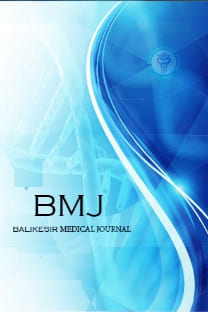Çölyak hastalığı ile komplike nadir görülen otoimmün poliglandüler sendrom; tip3B
Otoimmün poliglandüler sendrom, Çölyak hastalığı, Tip 1 diabetes mellitus, Otoimmün tiroid hastalığı
Rarely seen autoimmune polyglandular syndrome; Type 3B complicated with celiac disease
Autoimmune polyglandular syndrome, Celiac disease, Type 1 diabetes mellitus, Autoimmune thyroid disease,
___
- 1. Neufeld M, Maclaren N, Blizzard R. Autoimmune polyglandular syndromes. Pediatr Ann 1980; 9:154-62.
- 2. Cutolo M. Autoimmune polyendocrine syndromes. Autoimmune rev 2014; 13:85-9.
- 3. Michels AW, Gottlieb PA. Autoimmune polyglandular syndromes. Nat Rev Endocrinol 2010; 6: 270-7.
- 4. Betterle C. et al. Autoimmune Highlights 2014 5:27-31.
- 5. Current Medical Diagnosis and Treatment, fifty-fifth edition, 2016. Chapter 26, page: 1148.
- 6. Mahmud FH, Murray JA, Kudva YC, Zinsmeister AR, Dierkhising RA, Lahr BD, et al. Celiac disease in type 1 diabetes mellitus in a North American community: prevalence, serologic screening, and clinical features. Mayo Clin Proc. 2005;80(11):1429–34.
- 7. Dalgıc B, Sarı S, Özcan B, et al. Prevelance of cealiac disease in healthy Turkish school children. Am J Gastroenterol 2011;8:1512-7.
- 8. Bjorses P, Halonen M, Palvimo JJ, et al. Mutations in the AIRE gene: effects on subcellular location and transactivation function of the autoimmune polyendocrinopathy-candidiasis-ectodermal dystrophy protein. Am J Hum Genet. 2000 Feb. 66(2):378-92.
- 9. Rosatelli MC, Meloni A, Meloni A, et al. A common mutation in Sardinian autoimmune polyendocrinopathy-candidiasis-ectodermal dystrophy patients. Hum Genet. 1998 Oct. 103(4):428-34.
- 10. Zlotogora J, Shapiro MS. Polyglandular autoimmune syndrome type I among Iranian Jews. J Med Genet. 1992 Nov. 29(11):824-6.
- 11. Surendra Sivarajah, MD et al. Type 2 polyglandular autoimmune syndrome. Emedicine.medscape.com/article/124287. Updated Nov 08, 2016.
- 12. Ludvigsson JF, Bai JC, Biagi F, Card TR, Ciacci C, Ciclitira PJ, Green PH, et al. Diagnosis and management of adult coeliac disease: guidelines from the British Society of Gastroenterology. Gut 2014; 63: 1210-28.
- 13. Colin P, Kaukinen K, Valimaki M, Salmi J. Endocrinological disorders and celiac disease. Endocrine Rev. 2002;23(4):464-83.
- 14. Barker JM. Clinical review: Type 1 diabetes associated autoimmunity: natural history, genetic associations, and screening. J Clin Endocrinol Metab. 2006;91:1210-7.
- 15. Cosnes J, Cellier C, Viola S, Colombel JF, Michaud L, Saries J, Hugot JP, et al. Incidence of autoimmune diseases in celiac disease: protective effect of the gluten-free diet. Clin Gastroenterol Hepatol 2008; 6: 753-8.
- Yayın Aralığı: Yıllık
- Başlangıç: 2017
- Yayıncı: Balıkesir Üniversitesi
SELEKTİF OTOFAJİ VE ALT TİPLERİ
Şule ÖZEL, Serkan BODUR, Yaprak ENGİN-ÜSTÜN
Birinci trimester fetal baş popo mesafesi ile doğum ağırlığı arasındaki ilişki
Çiğdem Yayla Abide, Ebru Çöğendez, Pınar Kumru, Murat Keskin, Evrim Bostancı Ergen, Çetin Kılıççı
HIV/AIDS Hastalarında ELİSA Yöntemi İle Cryptosporidium Türlerinin Sıklığının Araştırılması
Eritema Nodozum Tanısı almış Pediatrik Hastaların Değerlendirilmesi: 6 Yıllık Deneyim
Mehmet KÜÇÜK, Demet CAN, Murat HIZARCIOĞLU
Serdar HIRA, Hatice Gülşah KARATAŞ, İsmail HASKUL, Ramazan GÜNDÜZ, Betül ÜSTÜN, Müfit AKYÜZ
Fitzpatrik’in Ritim Kuramına Göre Mide Malign Neoplazmı Olan Hastanın Hemşirelik Bakımı: Olgu Sunumu
Ayşe SERPİCİ, Birsel Canan DEMİRBAĞ
Çölyak hastalığı ile komplike nadir görülen otoimmün poliglandüler sendrom; tip3B
Hakan Aydın, Zülfükar Bilge, Abdullah Algın, Hüseyin Avni Fındıklı, Bünyamin Aydın
